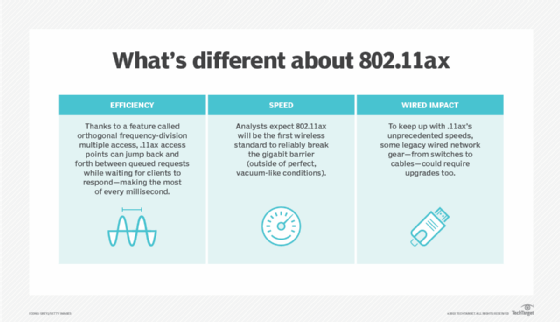
mangpor2004 - stock.adobe.com
Wi-Fi 6 glossary of 12 important terms and phrases
This Wi-Fi 6 glossary delves into various features and capabilities the new generation of Wi-Fi technology offers, as well as what organizations can expect from Wi-Fi 6 devices.
Wi-Fi 6 technology touts enhanced efficiency, increased data transfer speeds and major effects on legacy, wired networks. In response to this new standard, organizations should prepare and evaluate their potential moves to Wi-Fi 6 networks.
While consumers may reap Wi-Fi 6 benefits sooner than organizations, it isn't too early for network teams to prepare for the new generation of Wi-Fi technology. With various new features and upgrades from its predecessors, Wi-Fi 6 technology aims to differentiate itself from older generations and benefit networks in more advanced and technologically innovative ways.
This glossary explores 12 key terms and phrases that play major roles in Wi-Fi 6 technology and the potential effects these innovations could have on networks.
The Wi-Fi 6 glossary
802.11ac. Also known as Wi-Fi 5, 802.11ac is the fifth generation of Wi-Fi technology and Wi-Fi 6's predecessor. Experts claimed 802.11ac was evolutionary, and it offered enhanced video streaming capabilities and quicker data backup speeds. Wi-Fi 6 aims to pick up where 802.11ac's promises fell short or where they weren't fully realized, such as maximum data rate and frequency goals.
Access point. A wireless AP device transmits and receives data over a wireless LAN (WLAN). While AP devices are similar to wireless routers, APs can provide services to larger geographic areas than routers can. Several vendors already announced or released Wi-Fi 6 APs, which build upon 802.11ac APs and offer more IoT capabilities.
Bandwidth. One word to define bandwidth is capacity -- in particular, a network link's capacity. To go deeper, bandwidth is a network link's capacity to carry a maximum amount of data per second between specific network points. Wi-Fi 6 technology promises enhanced bandwidth, as well as improved bandwidth efficiency across networks.
Beamforming. Beamforming is a form of radio frequency management for APs, where one AP uses various antennas to transmit the same signal. This method helps networks determine the best route signals should take to reach devices efficiently. Wi-Fi 6 technology takes advantage of and expands upon this management method, which can lead to fewer dead zones across a network.
Institute of Electrical and Electronics Engineers Inc. The IEEE is an organization for electrical and electronics engineering with a goal to continuously bring about new advancements in technology. The IEEE Standards Association focuses on developing and setting standards for new technologies. This association dictates the wireless standards Wi-Fi products must meet, and it has played a key role in various Wi-Fi generation developments, including Wi-Fi 6 technology.
Latency. Latency is the time a packet takes to cross a network or move between points on a network. Through capabilities such as orthogonal frequency-division multiple access, or OFDMA, Wi-Fi 6 technology offers lower latency than its predecessors, as well as increased efficiency in data transfers.

Multiple input, multiple output. MIMO is a type of transmission technology made up of multiple antennas that use smart antenna technology, which enables data sources to quickly communicate with their destinations with few potential errors. Wi-Fi 6 uses multiuser MIMO, so organizations can support multiple users on a single network environment simultaneously.
Orthogonal frequency-division multiple access. OFDMA derives from orthogonal frequency-division multiplexing, which encodes data on multiple carrier frequencies. OFDMA takes this capability to a new level and is specific to Wi-Fi 6 technology. OFDMA enables Wi-Fi 6 APs to connect to and aid multiple devices simultaneously, thereby increasing efficiency, whereas traditional APs can only connect to a single user or device per channel.
Wi-Fi. Wi-Fi denotes specific WLANs that comply with 802.11 standards and transfer data between supporting devices. Wi-Fi uses radio waves to transfer data across LANs, which is then translated to computers or other Wi-Fi-compliant devices. Wi-Fi 6 is the sixth generation or evolution of these standards.
Wi-Fi 6. Also known as 802.11ax, Wi-Fi 6 is the latest generation of Wi-Fi standards and the first generation released with the Wi-Fi Alliance's new generational naming method, which lists the generations simply in chronological order of release. Past generations were referred to by their lettered place in the 802.11 hierarchy, according to IEEE specifications and naming conventions. These included 802.11b (Wi-Fi 1), 802.11a (Wi-Fi 2), 802.11g (Wi-Fi 3) and 802.11n (Wi-Fi 4).
Wi-Fi 6 technology promises improved use of bandwidth, faster data transfer speeds and major effects on wired network gear and infrastructure. These effects include potential for bottlenecks due to increased speeds, and Wi-Fi 6 could require organizations to fully upgrade their network infrastructure.
Wi-Fi Alliance. The Wi-Fi Alliance is an organization that promotes and certifies wireless technologies and products, such as Wi-Fi routers, APs and phones. The alliance developed the term Wi-Fi itself, and in late 2018, it also released the new generational naming conventions, such as Wi-Fi 4, Wi-Fi 5 and Wi-Fi 6. The Wi-Fi Alliance and IEEE work together to bring forth new Wi-Fi generations.
Wireless router. A wireless router is a device that determines where a packet travels on a network to reach its destination, and it operates similarly to an AP. However, APs are more suited to larger organizations and enterprises, while wireless routers are more common in homes and small businesses. Homeowners and small business owners may prefer Wi-Fi 6 routers more than enterprises would.






